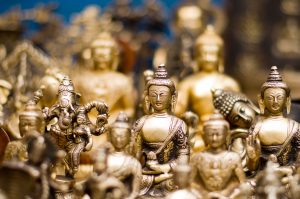As many countries enact lockdowns — closing borders, restricting movements — due to the coronavirus pandemic, many of us will not be able to travel to foreign countries – or indeed, even within our own states. But what we can do during this virtual lockdown is to explore the world – virtually. Here are some suggestions of Indian museums which you can visit without leaving your home.
While these institutions are now closed too, a few museums offer well-prepared virtual exhibitions and other resources worth exploring.
The Chhatrapati Shivaji Maharaj Vastu Sangrahalay in Mumbai (Maharashtra) offers some of the most graphically original online exhibitions among all Indian museum websites I am aware of. Most of those available were digitized in collaboration with Google Art & Culture, which helps museums in putting their exhibits online. Of this institution’s exhibitions, available here, I particularly recommend “Animal in Indian Art” (complete with scenes from Chuha-Nama, a fable on a war between rats and a cat!) Another of the online galleries is an informative review of various types of sari.
Another Indian institution which cooperated with Google Art & Culture is the Dr. Bhau Daji Lad Mumbai City Museum. It has joined the We Wear Culture project, which delves into the stories behind attire. To achieve this, the initiative has roped in dozens of museums from various countries, including both of the Mumbai museums mentioned above.
The online exhibits of India’s National Museum are available here. Their advantage is that some of them teach us about select exhibits part by part, with each slide explaining another aspect. Check, for instance, the slides on Hindu, Buddhist and Jain religious sculptures (the third from the top in the above link).
The Victoria Memorial Hall museum (Kolkata, West Bengal) also offers good virtual exhibits, mostly of art – especially paintings – but also of other historical objects. Their strong suit is that, like in the case of the National Museum, some of the exhibitions are presented through slides, complete with descriptions and explanations. My favorite is the collection of lithographs of colonial Kolkata (Calcutta), though these come with very rudimentary descriptions.
For those favoring longer explanatory notes, I suggest the virtual galleries of another museum in Kolkata – the Indian Museum – such as the one on Buddha, which narrates the history of his life and teaching through objects of art.
The National Gallery of Modern Art also offers virtual galleries for a part of its collections. Privately, I recommend watching the landscapes and people of colonial India through the eyes of European traveler artists.
Speaking of foreign painters and leaving museums for a moment: In 2011, Poland produced a documentary on the life of Stefan Norblin, a Polish painter famous especially for the work he has done in Umaid Bhavan (Jodhpur, Rajasthan). You can watch the whole movie, titled Chintraanjali. Stefan Norblin in India, here. The film gives a rare glimpse not only into Norblin’s life, but the world of his art deco paintings as well (the movie is in English, while the subtitles are in Polish).
The Virtual Museum of Images and Sounds is another treat. It lets us explore such materials as sound recordings or archival photographs. One can, for instance, browse the Mapping Music section to read about various types of Indian folk music and to listen to them (after clicking one of the icons on the map you need to click on the item’s name in the unrolling window in the upper left corner of the map).
Staying with the subject or audio resources for a moment, the 1947 Partition Archive, while not a physical museum, is a rare and tremendous project in the context of South Asian history. The team behind it collected over 9,000 stories of people that moved – or were forced to move – during the Partition of India in 1947. The stories, which document the often poignant fate of people from both side of the border – the Pakistani and the Indian one – have been recorded and archived; one can listen to them on the website
Like the 1947 Partition Archive, Harappa.com is not a physical museum but an online collection of resources. The website focuses on the ancient Indus Valley Civilization, on a period thousands of years before these territories were divided into India and Pakistan. A household name, Harappa.com offers not only photographs of archeological sites of the this civilization but also articles on its history.

































